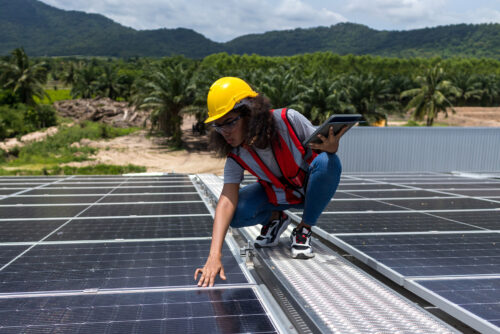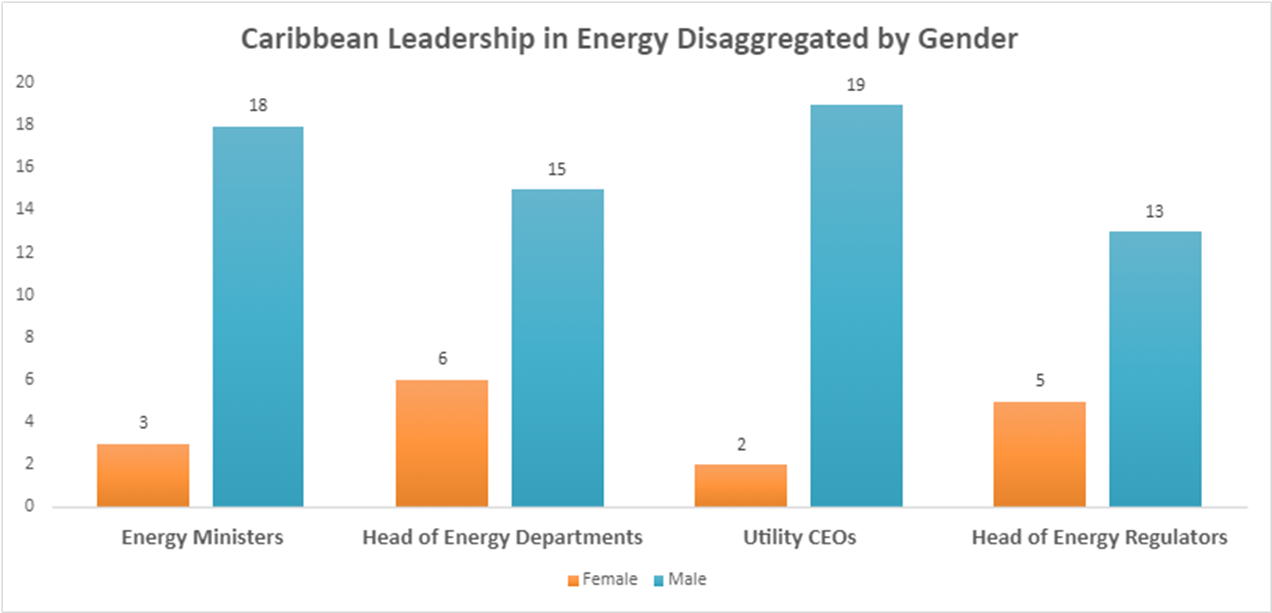
We Need More Women in Science and Leadership
We need more women and girls in science, technology, engineering, and mathematics to accelerate an equitable energy transition.
My story as a “woman in energy” is not uncommon. Etched in my memory is my first university graduation which landed me a shimmering gold medal award for the highest recorded academic performance in the faculty of Engineering and Natural Sciences. Surely, I was about to show the world that girls and women can do engineering too! Yet my dreams of becoming a locally acclaimed environmental engineer were tested time and time again.
I started teaching science at my all-girl’s high school alma mater in St. Lucia to encourage and influence the next generation of female STEM change-makers. I think I made a difference, as one of my former students — who now has a postgraduate degree in Astrophysics — credited me as being the influence for her to pursue a science degree. “My very first physics teacher, Charlin Bodley, made me fall in love with physics at secondary school,” Cheyenne Polius told the Organisation of Eastern Caribbean States. “Physics is a male-dominated field. It is certainly not the norm for a woman to pursue a physics degree. So, with Charlin being my first physics teacher, it showed me that it was perfectly fine for a woman to love physics and I believe this gave me a head start in my journey as a woman in science.”
Convinced by my unwavering passion to be an agent of change in the Caribbean energy transition, I again proved that the underrepresentation of women in science, technology, engineering, and mathematics (STEM) was not attributed to the inability of women to gain the necessary knowledge and skills. I graduated with a master’s in energy engineering, completed research on the technical and economic feasibility of a 100 percent renewable energy transition of Saint Lucia’s power sector, and earned a postgraduate degree in geothermal project management and financing. Yet the struggles of being a woman in energy persisted throughout the early years of my career.
Credit goes to the outstanding mentors along the way, such as my first manager, Judith Ephraim-Schmidt, now a member of the Women in Renewable Energy (WIRE) Network and a leader in the energy transition. Credit also goes to the WIRE Network, which provided me with a two-year mentorship program. Having role models and being part of such a dynamic network of women in energy strengthened my persistence in the sector. Determined to create a more diverse workforce, I continue to pair my technical background with a passion for gender integration into the energy transition.
February 11 marks the International Day of Women and Girls in Science, a reminder for the global community to recognize and invest in closing the chasm that remains in technical fields. Women represent less than 35 percent of STEM graduates, and less than a third of researchers globally. Part of RMI’s solution through the Energy Transition Academy (ETA) is to advance the mission of the WIRE Network, a community designed to support networking, technical capacity building, and mentorship opportunities for over 600 Global South women energy professionals.
While we may understand the technical pathways to enable the energy transition, a just and inclusive transition also involves complex social dynamics. Leaders must respond to the needs of diverse stakeholders including women, as gender is one critical factor that heavily influences the framing of apt responses to arresting climate change.
Despite progress through leadership, entrepreneurship, and other contributions at the community, regional, and national levels, women and girls remain disproportionately affected by deep-rooted cultural and social norms as well as climate change. Women are still largely underrepresented in STEM fields, which would equip them with the necessary skills, knowledge, and professional opportunities to drive the energy transition. Notable gender gaps persist in the energy sector, which has been historically male dominated. According to the IEA, the energy sector workforce has 76 percent fewer women than men. This is a notable difference from the total global workforce with a gender gap of roughly 8 percent. Similarly, women make up only 32 percent of the renewable energy workforce. And a closer look shows that only 28 percent of STEM positions in the renewable energy sub-sector are held by women, compared with 45 percent of administrative jobs occupied by women.
The gender imbalance in the workforce is reflected in board rooms and other leadership tiers, as women in the energy sector are far outnumbered by their male counterparts. A 2022 study of 155 countries revealed that 80 percent of senior management roles in the energy sector are held by men. Comparatively, fewer women are hired into senior roles in energy than in most other industries. In the power sector women represent only 14 percent of senior leadership and only 5 percent of executive board membership.
I have often advocated for an evidenced-based approach specific to various regions and sectors to tackle persistent gender gaps effectively. Interestingly, men and women vary in their perceptions of gender imbalances, and consequently, a stark gender imbalance in decision-making roles can exacerbate gender inequality. This is true in the Caribbean, which sometimes demonstrates even more disheartening gaps than global averages.

An Engendered Transition: Workforce Development Is Smart Economics
The selling point of orchestrating a gender-balanced transition is the power of diverse perspectives to improve business operations and drive profit. Gender balance in the energy workforce can breed innovation and provide agile solutions to more swiftly and effectively attain the paradigm shift needed for decarbonization. A study of S&P 500 companies found that companies with above-median women representation on their management teams benefit from a 30 percent higher return on equity than lower-ranked peer companies. Specifically, women’s representation on boards results in a 15 percent higher return on equity, when compared with less diverse peer companies.
In its World Energy Transitions Outlook 2022 report, IRENA estimates that a 1.5°C-aligned energy transition will result in 139 million energy sector jobs worldwide by 2030. Of those jobs, 38.2 million will be in renewable energy and 74.2 million in other energy transition-related sectors (e-mobility, energy efficiency, etc.). This provides an opportunity to reskill and upskill a balanced and diverse transition workforce. Leveraging women’s participation as agents of change can incentivize, influence, and accelerate the transition and truly leads to a win-win outcome. The radical implementation needed to convert centralized, fossil fuel-based energy systems to more innovative, sustainable, environmentally responsible, and socially responsive systems provides critical emerging opportunities for women to bring diverse perspectives and support catalytic approaches.
Despite growing research and a consequent case for women bringing diverse experience, skills, and perspectives in the power sector transition, the disparity in women’s meaningful participation persists. Inaction in closing the gender gap in the clean energy transition can be more costly than maintaining a business-as-usual approach to workforce development.
This month, RMI will publish a report on a new green jobs framework, which includes the importance of not only considering how many jobs can be created, but also for whom, and what socio-economic implications that will have more broadly.
The WIRE Network’s Mentorship Program
This is the basis for the WIRE Network. WIRE responds to the dire need to dismantle access barriers for women throughout workforce pipelines by providing professional upskilling and empowerment opportunities to its members. The flagship mentorship program focuses on formal career development and experiential learning to unleash untapped potential of mid-level women professionals in clean energy. It caters to the needs of women to provide them access to familial and professional networks to simulate valuable connections and provide peer support.
WIRE, as part of RMI’s Energy Transition Academy (ETA), maintains ETA’s approach to tailored and localized workforce development by seeking to leverage areas with strong potential for increased gender diversity. These areas include public and private sector leadership, governance, STEM, and the finance sector. WIRE is currently focused on the Caribbean, but with adequate support we hope to expand across economies of the Global South such as in Africa and in the Pacific.
Dismantling Male Dominance to Accelerate Investment
To maintain a 1.5°C-compatible transition scenario, IRENA estimates needing investments of US$5.7 trillion annually until 2030. Energy transition decisions are long-term investments and must therefore be guided by long-term logic. Research shows that women are more likely to support investments in renewable energy than their male peers. According to the “Women’s Forum 2021 Barometer,” women are more likely to make climate-positive decisions toward reducing emissions. Research also confirms that in the corporate world, boards with higher representation of women are more likely to proactively invest in renewable energy and to reduce carbon emissions throughout their value chain.
Women are typically more connected to the last-mile efforts for localized energy transition actions and are also more likely to capture new markets emerging from the energy transition. Thus, we need women entrepreneurs and leaders who can directly influence investment in renewable energy.
“Women are already taking the lead in the energy transition”, notes Raul Alfaro-Pelico, RMI Senior Director for the Global South Program, “we need to continue developing an inclusive workforce, if we want to fast-track clean energy deployment.”
Leadership Acceleration: The Role Model Effect
The glass ceiling effect is particularly evident in the energy transition workforce, with too few women acquiring leadership positions. Consequently, women role models and leadership success stories are too few to successfully attract more women to the sector. Contrarily, deliberately creating leadership pipelines of female role models and mentors through the advancement of the existing cadre of women professionals in the sector can attract more women to enter the sector.
The World Economic Forum suggests that women will choose career pathways for sectors that already employ a lot of women and that show equitable career mobility and advancement of women. We must enable women to break through glass ceilings, and equitably occupy space in the energy transition. The IEA has confirmed this, stating that “if women working in the energy sector are unable to advance in their careers, they will be motivated to change sectors.”
Coincidentally, the theme for International Women’s Day on March 8 this year is innovation and technology for gender equality, and we invite you to join RMI in closing the gender gap in STEM by supporting programs designed to upskill, empower, and connect women to accelerate the energy transition and meet the ever-closer climate 2030 deadline.
Urgent action is needed to increase opportunities for women and girls to lead today, to attract a diverse workforce pipeline of tomorrow.
